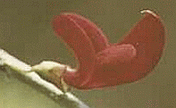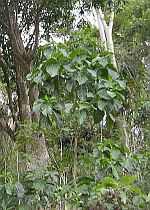

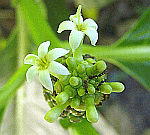
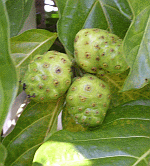

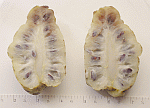
|
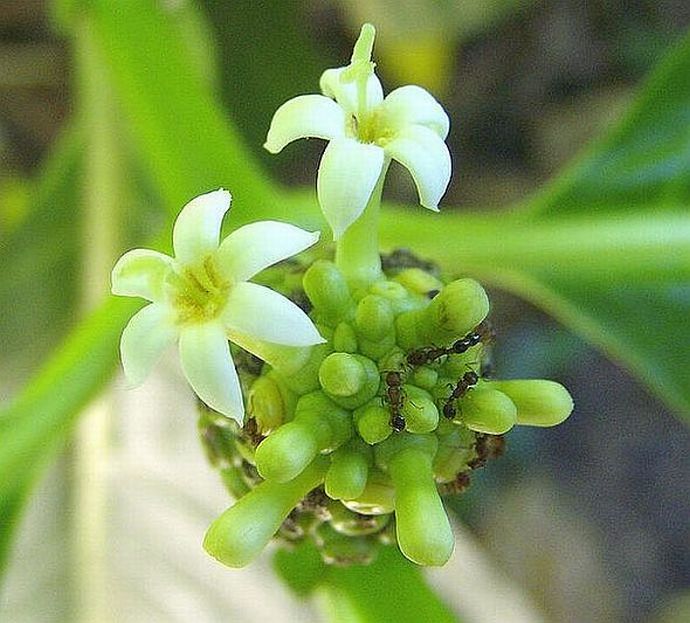
Wilfredo Rodríguez
Description: Source of folk medicine’s famous Noni Juice; small tree, up to 6 m tall (20 ft); young branches 4-angled, stem light gray to tan, up to 30 cm diameter (12 in), with branches coming off low on stem; leaves opposite, large, simple, ovate, shiny dark green, and deeply veined, up to 45 x 24 cm (17.5 x 9.4 in); flowers small and white, in axillary inflorescence with united ovaries; compound fruit an ovoid, irregularly bumpy, fleshy syncarp, green at first, then off-white when ripe, with pungent, fetid odor, medium sized, 12 x 8 cm (4.7 x 3.1 in); flesh also off-white, with numerous seeds, roughly 10 x 5 mm (0.2 x 0.1 in); flowering and fruiting year round; one specimen in southern part of Gardens on slope near large Velvet Tamarind tree.
Plant Family: Belongs to the Rubiaceae or Coffee family, which includes Ixora (Ixora coccinea), the diminutive Langue Poule (Oldenlandia corymbosa), and obviously, Coffee (Coffea arabica).
Natural Habitat: Found in wide variety of habitats, especially shady or secondary forests and open, rocky or sandy sea shores; tolerates drought and saline soils. Common near beaches in Dominica.
Origin and Distribution: Native of Southeast Asia and now extensively distributed throughout India, the tropical Pacific and Caribbean.
Uses: Numerous, mainly medicinal uses; has centuries old reputation for wide use in folk medicine, and recently there was brisk business worldwide in Noni juice; all parts of tree (leaves, flowers, fruits, bark, roots) used in traditional medicine; for brevity, only some uses are noted here; leaves used for rheumatism by Caribs, for muscle and joint pain in Surinam; in Asia, for malaria, to reduce fever and relieve pain (hence Painkiller); leaf or fruit poultice used for tuberculosis, sprains, bruises and rheumatism; extract of fruit, leaves or bark used to treat hypertension; fruit used for production of tonics, with fruit juice widely used in India as health enhancer, and as treatment for Cancer; fruit poultice used for boils and carbuncles; fruit oil for stomarch ulcers; in Indochina especially, fruit used for asthma, lumbago, and dysentery; in Hawaii, juice of fruit used to regulate menstruation, and as shampoo to treat head lice; bark decoction used for jaundice; seed oil used for head lice; and all parts of plant used as laxative; reportedly, laboratory experiments show Noni juice increasing physical endurance in mice; and pilot study showed increased endurance of distance runners; among other uses: fruit eaten as famine food, and, in some Pacific islands, as staple, either raw or cooked, despite strong smell and bitter taste; bark produces brownish-red dye for making batik; yellowish dye from root used to dye cloth in Hawaii.
Indigenous Legends: Local Dominican name, Pangkila, thought to be derived from another of Noni’s common names, Painkiller.
References:
Scot C. Nelson. Species and profiles for Pacific Island Agroforestry: Morinda citrifolia (Noni). College of Tropical Agriculture and Human Resources, University of Hawaii at Manoa, Hawaii, April 2006 (www. traditionaltrees.org)
Dan H. Nicolson. Flora of Dominica, Part 2: Dicotyledoneae. Smithsonian Institution, Washington, D.C. 1991
Robert A. DeFilipps. Useful Plants of the Commonwealth of Dominica, West Indies. Smithsonian Institution, Washington, D.C. 1998
Noni. Wikipedia, The Free Encyclopedia, January 2009 (en.wikipedia.org)
Penelope N. Honeychurch. Caribbean Wild Plants and Their Uses. Macmillan, London, 1986
C.D. Adams. Flowering Plants of Jamaica. University of the West Indies, Mona, Glasgow University Press 1972
Anon. [Joseph Jones?]. Official Guide to the Botanic Gardens, Dominica. Kew Gardens, London 1924?
|

